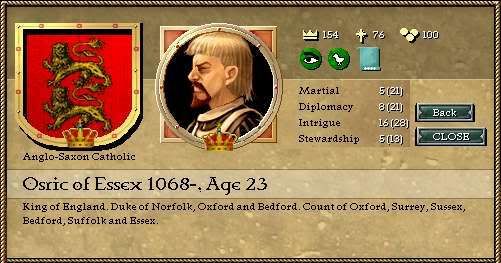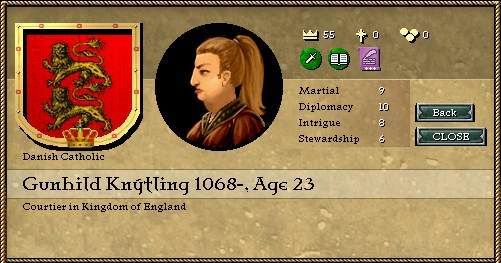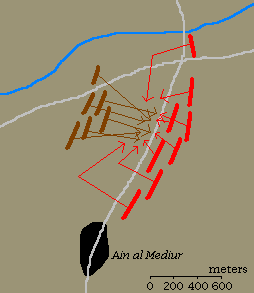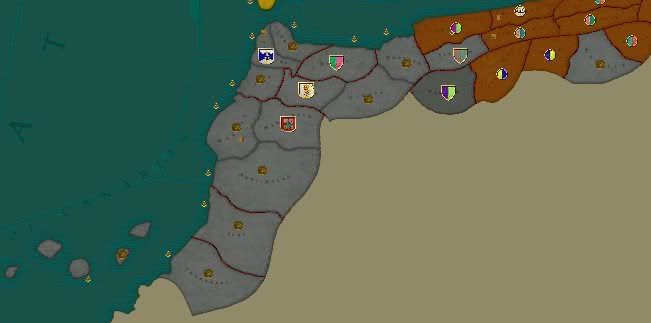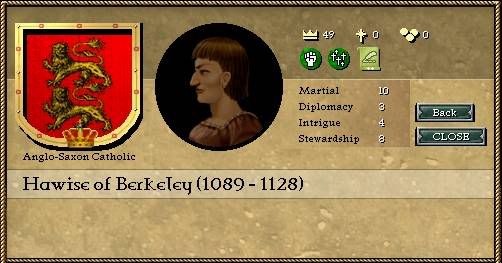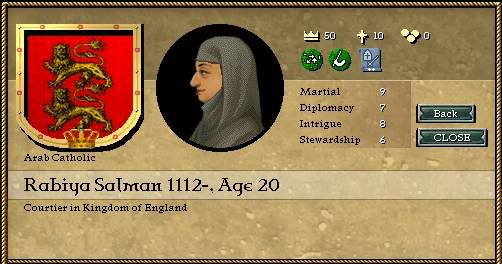[Okay, sorry about being horribly late with this one; there will still be another update this weekend.
Llywelyn:
A propros* to Kentucky, my original idea with an England game had been to play as Humphrey de Bohun, de Bohun being the old Norman form of Boone.

]
Osric I Háligwar ("the Saint")
Born: 1 June 1068, London
Married: [1] Gunhild Knýtling (on 10 July 1084) [2] Jutte van Vlaanderen (on 14 January 1101)
Died: 21 August 1128, London
Osric's most formative years had been in London and the surrounding area, although he had spent a decade with his father in Tangiers. This had gained him both a keen eye for the technology and advanced throught evident in the Muslim countries, and a personal feeling that he would need to continue his uncle Edgar's work in Spain and North Africa. His successes and failures in these areas would gain him an important place in English history.
By the time he came to the English throne his influence was already great. Besides his father's position as an Earl of England (even if it was in a far-off desert) and former regent to the King, his eldest son Sigebert had already gained the inheritance of the duchy of Skåne through his mother (He also had another son and a daughter in 1091, Aethelwulf and Agatha). This had been a compromise, as it was obvious by that point that Osric would become King of England, and the King of Denmark was wary of a part of his kingdom becoming English. Since Sigebert would eventually inherit it was felt that this delayed the event long enough for King Hans' purposes.
Osric himself was already known as a bright (if somewhat uncompromising--during the beginning of his reign, he was known as
þéawléas, "ill-mannered") mind, and his first action was a major example of this. Waltheof, the Earl of York, had inherited the earl of Hereford, thus giving him a large area of central England. This could potentially be a direct threat to Osric's reign if Waltheof ever decided to oppose him.
Osric carefully maneuvered, managing to take the earldom of Hereford out from under him and giving it to Oswald of Oakham, the
thane** of Shrewsbury. He would later weaken him further by granting two of his vassals (Leofric of Wellington and Uhtred, a junior member of the Siward family) the titles of Duke of Oxford and Duke of Norfolk (respectively).
The early part of his reign was concerned with other internal matters, especially innovation. He brought ideas of thought both from the libraries of North Africa (of which he made care that they were acceptable to the religious authorities of England) and the European continent. After about two and a half years, Osric felt confident enough that these would improve and spread on their own, and turned outward.
His first area of interest was Wales. The area had been completely ignored during the reign of Edgar II, and Osric wanted to remind the Welsh--who were uniting under Maredudd, Prince of Gwynedd--who was the main authority between the two. On 11 August 1093 he began the first of his family's wars against Wales, which while short (Maredudd accepted Osric's terms by 29 November) and indecisive (it was more a statement by Osric, and no land changed hands, and soon after Maredudd felt confident enough to call himself Prince of Wales) also cemented Osric's position as the main ruler in the British isles, a position from which England would only expand.
Osric once again took some time to build up infrastructure in England, until, on 20 April 1097, he restarted the English fight against non-Christians. His target was the Prussians, a tribe which was threatening the Kingdom of Poland. After a grand feast he held for his nobility, he set out and took the region of Nogat in December, where he built Marysceaster (Mary's Castle), which became the Teutonic
Marienburg and the Polish
Malczest or
Malbork. He then took Cealmin (Pol.
Chełmno in February 1098 and Galindland (now
Mazury or Masuria) in April.
By 16 May, having weakened the Prussians enough for the Poles to finish them off, Osric took a tribute from the Prussian ruler and gave the land to a Polish noble, making him Thane of Cealmin and ruler of the other areas he had taken (the King of Poland would later make him Voivode of Prussia). Osric's small action against the Prussians would give the Poles enough breathing room to impressively fight back; the Polish conquest of the vast lands of what is now the Ukraine, which Osric's expedition allowed for, are well known.
In that year two more important events occured: the birth of Osric's second daughter Eadhild, and the death of his wife Gunhild when she became ill after the birth. The death struck Osric so much that he did little for several years, only recovering when he married Jutta, second daughter of Baldwin, Duke of Flanders, in 1101. He wasted no time, his third son Harold being born later that year. He would have two more sons (Hlothere and Eanbert) and one more daughter (Aelflaed) with her who would survive infancy.
England celebrated in December of 1101, as the Papal Curia, after the death of Pope Urban II, elected the Archbishop of Canterbury, who became Pope Paschal II. Paschal would set forth the (in)famous bull
Laudabiliter, which supported English rule over the British Isles. While it had little power of enforcement, Osric and later kings would use it as an excuse to expand their rule.
Another event which would later be seen as important (although more at Osric's expense) was the calling of the Witan on 22 April 1103. This was hardly unusual in and of itself (it occured yearly), but Osric began to use it as a source of money when that proved necessary. Osric did so rarely himself, but later kings would do so more and more, which the later and more organized forms of the Witan would use to their advantage.
By September, with the Witan's money spent organizing an army and a navy, Osric began what would become his defining period, the crowning achievement of his reign. On 7 September 1103 he left Southampton, his ships carrying an army bound for North Africa. The English Crusade in Africa and Spain would begin in earnest.
[Next up: Will Osric fare better than Edgar in this pursuit? Or will his title of "the Saint" be due to martyrdom? Then again, the fact that he'll live for 25 more years and die in London might give some of it away.

]
__________
*I horribly mangled that, didn't I?

**The equivalents I'm using:
Thane (A-S
Þegn) = Count
Earl (A-S
Eorl) = Duke
King (A-S
Cyning) = King



